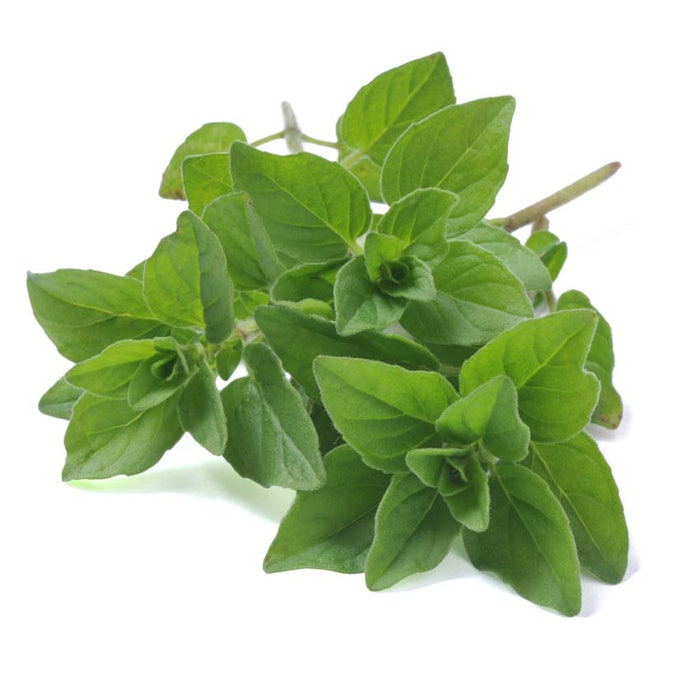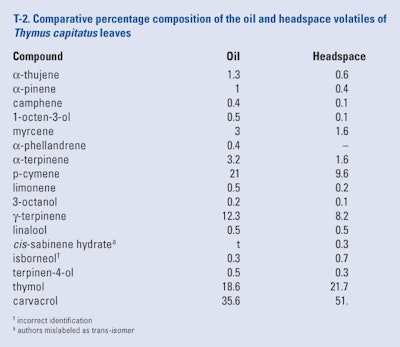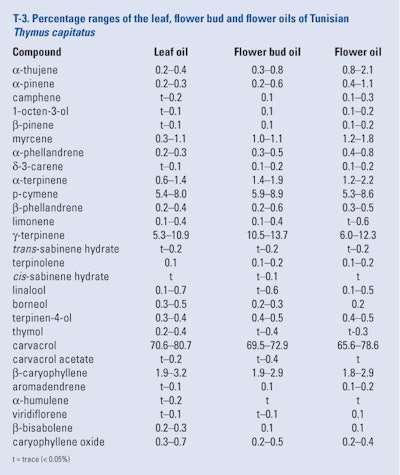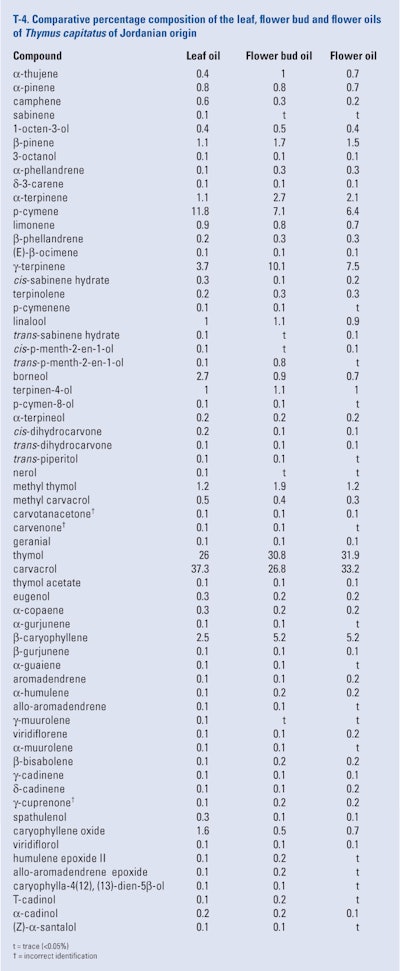
Spanish oregano oil is obtained from a woody, sub-shrub member of the Lamiaceae family known taxonomically as Thymus capitatus (L.) Hoffm. et Link [syn. CoridoThymus capitatus (L.) Reich G. F., Satureja capitata L., Thymbra capitata (L.) Cav.]. The commercial name of this oil is somewhat confusing because the plant is known as conehead thyme or Cretan thyme. Nevertheless, in the essential oil trade it is known as Spanish oregano because it is produced commercially in Spain even though the plant is found throughout southern Mediterranean countries.
Cosentino et al. (1999) examined Sardinian Thymus oils for their antimicrobial activity. Among the oils screened was a commercial sample of T. capitatus and a pilot scale, steam distilled oil of T. capitatus harvested when in full bloom. The oils were analyzed using GC/MS only and found to be rich in thymol, as shown in T-1.
Thymus capitatus leaves were collected from plants growing in Çes¸me-I·zmir (Turkey) by Goren et al. (2003). A hydrodistilled oil was produced in 1.1% yield during a 3-hr process. The authors also examined the headspace volatiles of the leaves (treatment not reported) using a thermal desorbing apparatus fitted with a Tenax-TA resin. Both the oil and headspace volatiles were analyzed using GC/MS only. The results are shown in T-2.
In addition, trace amounts (< 0.1%) of methyl isovalerate, methyl 2-methylbutyrate, terpinolene, (Z)-β-ocimene, trans-sabinene hydrate, a-terpineol, spathulenol and caryopyllene oxide were characterized in the leaf oil.
Skoula and Grayer (2005) collected T. capitatus plants from Asfendou (Crete, Greece) and hydrodistilled them when dried to produce an oil in 2.7% yield. Using GC and GC/MS, the researchers found this oil to possess the following composition. The study revealed the existence of a thymol-rich chemotype of T. capitatus.
α-thujene (1.1%)
α-pinene (1.1%)
camphene (0.5%)
β-pinene (0.2%)
3-octanone (0.6%)
myrcene (2.2%)
α-phellandrene (0.3%)
cis-dihydroxy-linalool oxidef (0.2%)
α-terpinene (1.9%)
p-cymene (19.6%)
limonene (0.8%)
δ-terpinene (13.7%)
cis-sabinene hydrate (0.2%)
terpinolene (0.3%)
linalool (0.1%)
trans-sabinene hydrate (1.2%)
cis-p-menth-2-en-l-ol (0.1%)
borneol (1.8%)
terpinen-4-ol (0.5%)
α-terpineol (0.3%)
cis-piperitol (0.3%)
methyl thymol (0.3%)
methyl carvacrol (0.1%)
thymoquinone (0.3%)
isobornyl acetate (0.1%)
p-cymen-7-olª (0.4%)
thymol (34.0%)
carvacrol (5.1%)
β-caryophyllene (5.4%)
α-humulene (0.2%)
germacrene D (0.1%)
β-bisabolene (0.1%)
f = furanoid form
ª also known as cumin alcohol
Bounatirou et al. (2007) used GC-FID and GC/MS to examine hydrodistilled oils of the leaves, flower buds and flowers of T. capitatus, collected from three locations in Tunisia. A summary of the results is shown in T-3. In addition, trace amounts (< 0.05%) of (Z)-β-ocimene, (E)-β-ocimene, eugenol and spathulenol were characterized in the oils.
An oil of T. capitatus produced in the laboratory from flowering plant material and harvested in Faro (Portugal) was screened for its nematicidal activity by Barbosa et al. (2010). The oil composition determined by GC-FID and GC/MS was found to be as follows:
α-thujene (3.4%)
α-pinene (1.2%)
camphene (0.1%)
β-pinene (0.2%)
α-phellandrene (0.1%)
α-terpinene (0.6%)
p-cymene (5.1%)
β-phellandrene (0.2%)
limonene (0.2%)
δ-terpinene (3.2%)
trans-sabinene hydrate (0.2%)
terpinolene (0.1%)
borneol (0.1%)
terpinen-4-ol (0.5%)
carvacrol (65.3%)
thymol acetate (0.5%)
carvacrol acetate (10.8%)
β-bourbonene (0.1%)
allo-aromadendrene (0.1%)
germacrene D (0.1%)
trans-β-dihydroagarofuran† (1.3%)
α-muurolene (0.2%)
trans-calamenene (0.1%)
γ-cadinene (0.6%)
T-cadinol (0.1%)
α-eudesmol (1.1%)
†incorrect identification
In addition, trace amounts (< 0.05%) of tricyclene, sabinene, 1-octen-3-ol, nonanal, linalool, 1-octen-3-yl acetate, α-gurjunene, kessane, elemol, δ-eudesmol, α-muurolol and β-eudesmol were found.
Voissin (2011) reported that a commercial sample of T. capitatus oil contained the following constituents:
α-pinene (0.3%)
camphene (0.1%)
myrcene (0.7%)
α-phellandrene (0.1%)
γ-2-carene (0.8%)
o-cymenea (4.4%)
γ-3-carene (0.3%)
δ-terpinene (3.3%)
borneol (0.5%)
terpinen-4-ol (0.5%)
thymol (0.2%)
carvacrol (84.4%)
β-caryophyllene (3.1%)
ª should be p-cymene
The oil compositions of the aerial parts (i.e., leaves, flower buds and flowers) of T. capitatus from Jordan were studied by Tawaha and Hudaib (2012). These authors examined the hydrodistilled oils using both GC-FID and GC/MS; their results are reported in T-4.
An essential oil produced from T. capitatus grown in Thessaloniki (Greece) and harvested during its full flowering stage was examined for its allelopathic effect on the germination of grass weed species found in fields of wheat and barley. The lab-distilled oil was analyzed by Gitsopoulos et al. (2013) using GC-FID (two columns, polar and non-polar) and GC/MS. The constituents characterized in the oil were as follows.
α-thujene (0.2%)
α-pinene (0.7%)
camphene (0.1%)
1-octen-3-ol (0.5%)
myrcene (1.4%)
α-terpinene (1.1%)
p-cymene (13.1%)
limonene (0.6%)
δ-terpinene (1.9%)
linalool (0.7%)
borneol (0.3%)
terpinen-4-ol (0.8%)
thymol (0.2%)
carvacrol (75.3%)
β-caryophyllene (1.4%)
caryophyllene oxide (0.7%)
Fresh leaves of T. capitatus were collected from plants growing in their vegetative state from Portopalo (Siracusa, Sicily). The leaves were homogenized and the headspace volatiles were extracted using a divinylbenzene/carboxen/polydimethylsiloxane (DVB/CAR/PDMS) fiber by Condurso et al. (2013). Desorption of the DVB/CAR/PDMS fiber and analysis by GC/MS only revealed the leaf headspace volatiles, listed in elution order from a polar column, were as follows.
α-pinene (0.6%)
β-pinene (0.1%)
sabinene (0.1%)
γ-3-carene (0.1%)
myrcene (1.0%)
α-phellandrene (0.2%)
α-terpinene (1.4%)
limonene (0.2%)
β-phellandrene (0.2%)
δ-terpinene (6.4%)
p-cymene (2.3%)
terpinolene (0.1%)
3-octanol (0.7%)
1-octen-3-ol (0.2%)
6-methyl-5-hepten-2-ol (0.2%)
linalool (2.1%)
isocaryophyllene (0.1%)
pulegone (1.0%)
terpinen-4-ol (1.5%)
β-caryophyllene (3.1%)
α-humulene (0.1%)
β-himachalene (0.1%)
α-terpineol (0.3%)
borneol (0.6%)
viridiflorene (0.1%)
bicyclogermacrene (0.2%)
carvone (0.1%)
(Z)-α-bisabolene (0.1%)
geraniol (0.1%)
cis-carveol (0.1%)
5,6-epoxy-β-ionone (0.1%)
humulene epoxide II (0.1%)
eugenol (0.1%)
thymol (0.6%)
carvacrol (72.8%)
In addition, the authors characterized the following as trace headspace volatile constituents in the Sicilian T. capitatus homogenized fresh leaves: methyl 2-methylbutyrate, methyl isovalerate, camphene, α-thujene, ethylbenzene, a p-menthene isomer, 6-methyl-5-hepten-2-one, α-copaene, α-gurjunene, β-elemene, an α-bergamotene isomer, δ-elemene, α-himachalene, a β-farnesene isomer, citronellol, α-muurolene, valencene, γ-cadinene, geranyl isobutyrate, geranyl propionate, a calamenene isomer, geranyl butyrate, caryophyllene oxide, humulene epoxide I, α-bisabolol, elemol and spathulenol.
The ISO report (1996) for Spanish oregano oil lists the constituent maximum and minimum levels as:
α-thujene (0.5–2.0%)
α-pinene (0.5–1.5%)
myrcene (1.0–3.0%)
α-terpinene (0.5–2.5%)
p-cymene (5.5–9.0%)
δ-terpinene (3.5–8.5%)
linalool (0.5–3.0%)
terpinen-4-ol (0.5–2.0%)
thymol (0–5.0%)
carvacrol (60.0–75.0%)
β-caryophyllene (2.0–5.0%)
However, the examination of previously reviewed literature (Lawrence 1980, 1982, 1988, 1993, 1995, 1999, 2004 and 2011) reveals the oil composition of the carvacrol-rich Spanish oregano oil—including the ISO-listed constituents—as follows, listed in elution order from a non-polar capillary GC column.
α-thujene (< 0.1–2.2%)
α-pinene (0.1–3.6%)
camphene (< 0.1–1.0%)
heptanol (< 0.1–1.7%)
sabinene (< 0.1–0.2%)
1-octen-3-ol (< 0.1–0.6%)
3-octanone (< 0.1–0.7%)
myrcene (0.3–2.8%)
6-methyl-5-hepten-2-ol (< 0.1–0.2%)
3-octanol (< 0.1–0.4%)
α-phellandrene (< 0.1–1.0%)
γ-3-carene (< 0.1–1.4%)
α-terpinene (0.1–2.7%)
p-cymene (0.6–17.0%)
limonene (< 0.1–2.6%)
β-phellandene (< 0.1–0.3%)
1,8-cineole (< 0.1–0.4%)
δ-terpinene (0.7–16.5%)
cis-sabinene hydrate (0.1–0.7%)
terpinolene (< 0.1–0.4%)
trans-sabinene hydrate (< 0.1–0.4%)
linalool (0.1–3.9%)
borneol (< 0.1–1.8%)
terpinen-4-ol (< 0.1–3.5%)
p-cymen-8-ol (< 0.1–0.6%)
α-terpineol (< 0.1–0.6%)
cis-dihydrocarvone (< 0.1–0.1%)
trans-dihydrocarvone (< 0.1–0.2%)
carvone (< 0.1–0.3%)
methyl thymol (< 0.1–0.3%)
methyl carvacrol (< 0.1–1.7%)
thymol (0.1–12.7%)
carvacrol (62.6–86.3%)
eugenol (< 0.1–0.3%)
carvacrol acetate (< 0.1–2.3%)
β-caryophyllene (0.7–4.8%)
aromadendrene (< 0.1–0.4%)
α-humulene (0.1–0.4%)
germacrene D (< 0.1–0.5%)
bicyclogermacrene (< 0.1–0.3%)
(Z)-α-bisabolene (< 0.1–0.4%)
β-bisabolene (< 0.1–0.4%)
γ-cadinene (< 0.1–0.4%)
spathulenol (< 0.1–0.5%)
caryophyllene oxide (< 0.1–0.9%)
Finally, Iriti et al. (2014) examined a hydrodistilled oil of the tops of T. capitatus produced from plants growing as wild flora in Lebanon. The oil was analyzed by GC-FID and GC/MS; the composition is summarized as follows.
α-thujene (0.8%)
α-pinene (0.7%)
camphene (0.2%)
β-pinene (0.2%)
myrcene (1.0%)
γ-3-carene (0.3%)
p-cymene (5.7%)
limonene (1.4%)
δ-terpinene (6.3%)
linalool (0.7%)
borneol (1.0%)
terpinen-4-ol (0.6%)
thymol (19.9%)
carvacrol (47.0%)
β-caryophyllene (2.6%)
allo-aromadendrene (0.2%)
β-bisabolene (0.5%)
γ-cadinene (0.4%)














